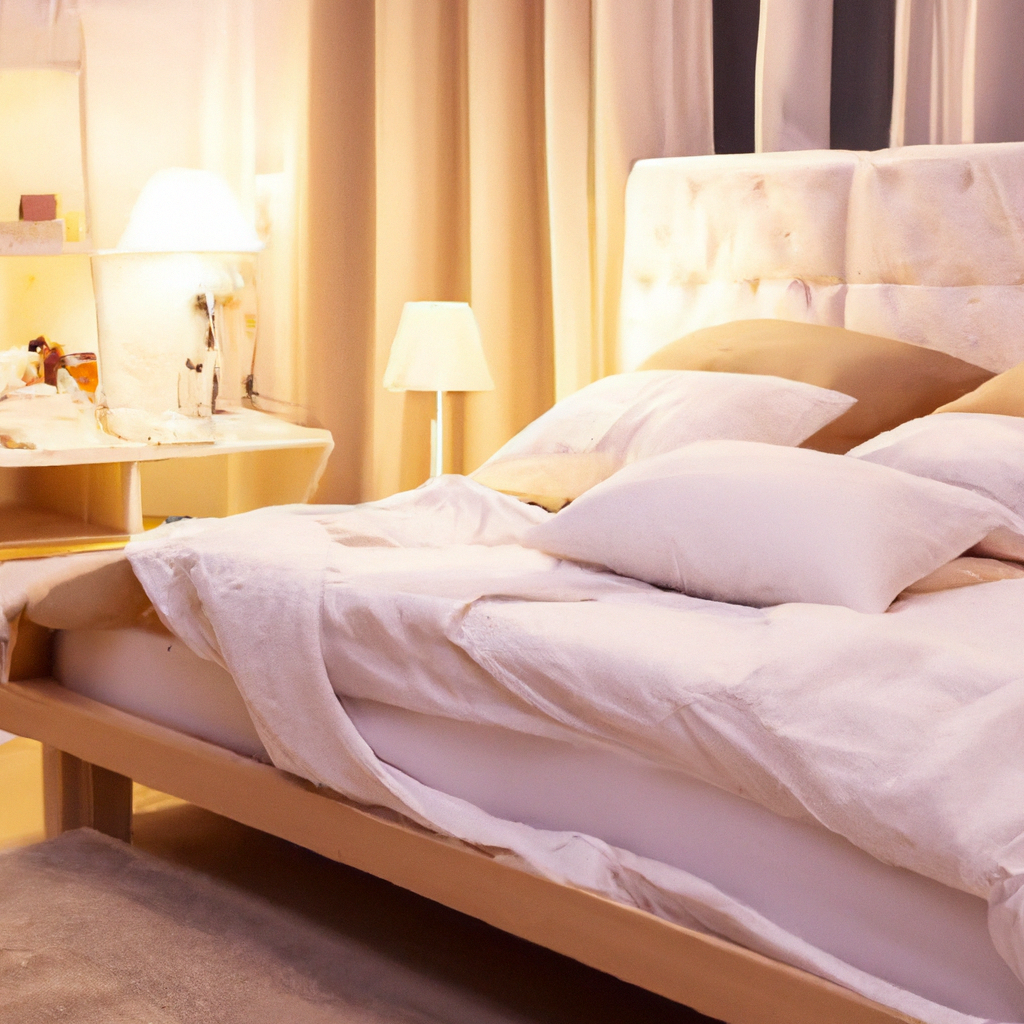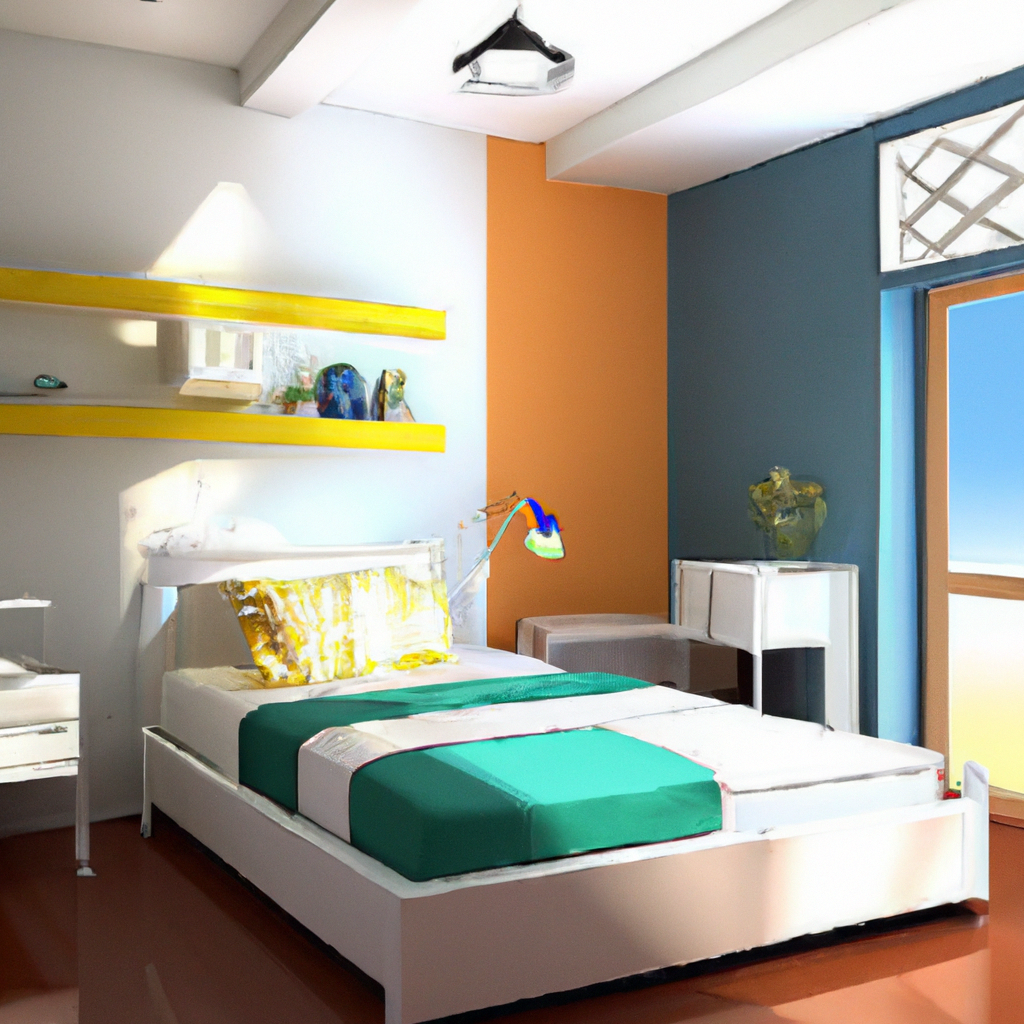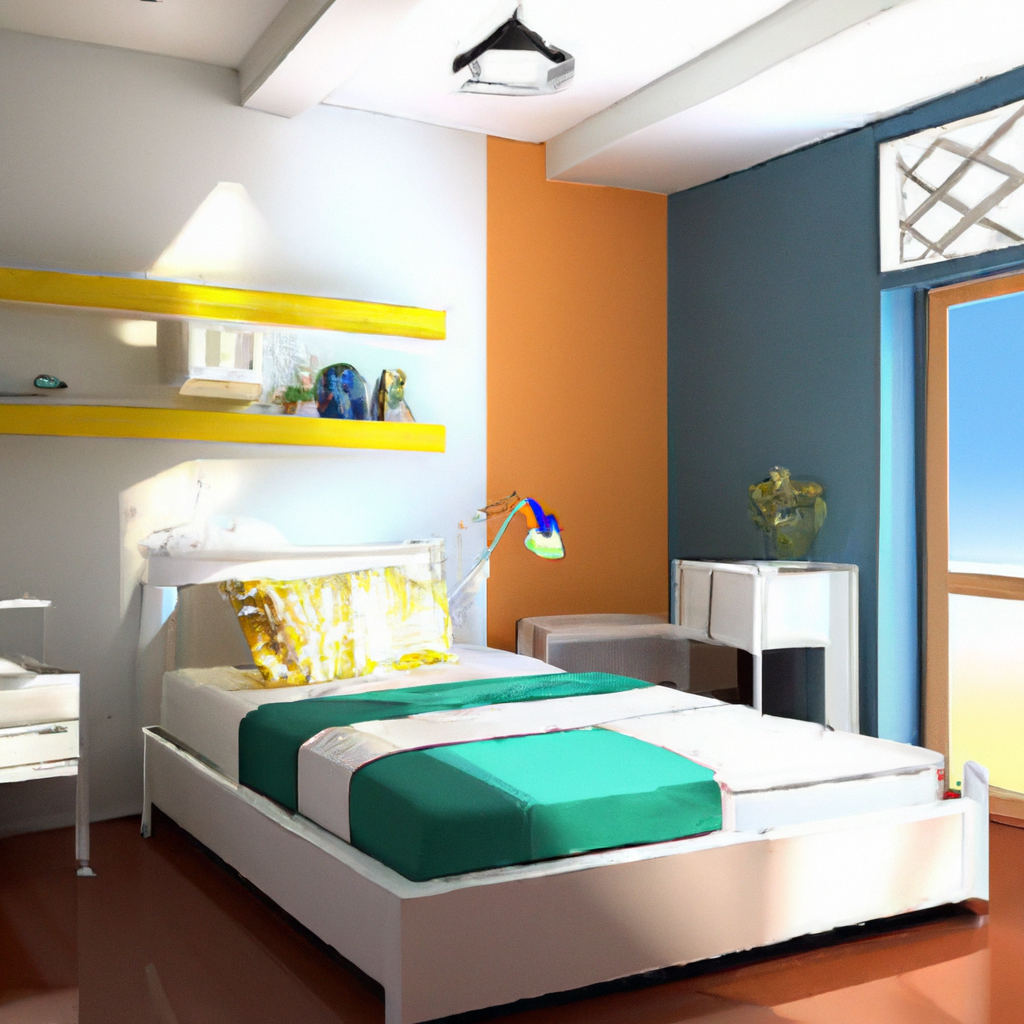Imagine having a bedroom that understands and caters to your unique sensory needs, providing a calm and peaceful environment tailored just for you. In this article, we will explore how to create a sensory-friendly smart bedroom specifically designed for individuals with conditions such as autism or ADHD. From soothing lighting and personalized temperature control to smart devices that offer calming sounds and routines, discover how to transform your bedroom into a comfortable and supportive sanctuary for a better night’s sleep and enhanced well-being.

Choosing the Right Smart Devices
Smart Lighting Systems
When creating a sensory-friendly smart bedroom, smart lighting systems play a crucial role. These systems allow you to adjust the brightness and color of the lights, helping to create a calm and soothing environment. You can customize the lighting to match the individual’s preferences and needs, whether it’s a soft warm glow or a cool blue shade. Some smart lighting systems even offer features like timers and dimming options, allowing you to gradually transition to sleep or wake up gently.
Smart Thermostats
Smart thermostats are another essential component of a sensory-friendly smart bedroom. These devices enable you to regulate the room temperature to ensure optimal comfort throughout the night. For individuals with sensory sensitivities, even a slight temperature variation can disrupt sleep and lead to discomfort. With a smart thermostat, you can easily set and maintain a consistent temperature that promotes better sleep quality.
Smart Sound Systems
To create a calming environment, incorporating a smart sound system is highly beneficial. These systems allow you to play soft and soothing music or ambient sounds that can help individuals with autism or ADHD relax and fall asleep more easily. You can customize the playlist or soundscapes based on personal preferences and adjust the volume to ensure it doesn’t become too overwhelming. Some smart sound systems even have built-in white noise or nature sounds options which can be particularly helpful for those who struggle with sensory overload.
Smart Curtains or Blinds
Smart curtains or blinds are an excellent addition to a sensory-friendly smart bedroom. These devices allow you to control the amount of natural light entering the room throughout the day. For individuals with autism or ADHD who may be sensitive to bright lights or who require a darkened environment to sleep, smart curtains or blinds can be adjusted with ease using voice commands or an app on your smartphone. This feature helps create a comfortable, sleep-friendly atmosphere during naptime or bedtime.
Smart Wake-up Lights
Smart wake-up lights are innovative devices that mimic sunlight to gently wake individuals up in the morning. These lights gradually increase in brightness, simulating a natural sunrise, promoting a more peaceful and refreshing awakening. For individuals with autism or ADHD who struggle with abrupt transitions, a smart wake-up light can provide a gentle way to start the day and improve overall sleep quality.
Creating a Calming Environment
Minimizing Clutter
Keeping a sensory-friendly bedroom free from clutter is essential for promoting a calm and peaceful environment. Excess items, toys, and decorations can be overwhelming for individuals with autism or ADHD. Having a clean and organized space with minimal distractions can help reduce sensory overload and encourage relaxation and focus.
Using Soft and Soothing Colors
Color plays a significant role in creating a sensory-friendly bedroom. Opting for soft and soothing colors, such as pastels or muted tones, can help create a calming atmosphere. Avoiding bright and intense colors can help individuals with autism or ADHD feel more comfortable and relaxed in their environment. Consider using color schemes that promote a sense of tranquility and offer a welcoming and peaceful space.
Controlling Noise Levels
Noise can be a major source of sensory overload for individuals with autism or ADHD. To create a sensory-friendly smart bedroom, it’s crucial to control noise levels. Installing sound-absorbing materials, such as acoustic panels or curtains, can help minimize external noise and echoes in the room. Additionally, positioning the bedroom away from high-traffic areas can help reduce noise disturbances.
Installing Soundproofing Materials
In some cases, additional soundproofing measures may be necessary to create a truly calming environment. Soundproofing materials, such as acoustic insulation or sound-dampening foam, can help minimize noise from outside the room or other parts of the house. These materials create a quieter and more peaceful space, reducing sensory distractions and promoting better sleep quality.
Designing a Cozy and Comfortable Space
A sensory-friendly smart bedroom should prioritize comfort. Choose furniture, bedding, and textiles that are soft, cozy, and comfortable to the touch. Soft blankets, pillows, and plush rugs can help create a soothing and inviting environment. Providing a comfortable and safe space for individuals with autism or ADHD will contribute to their overall well-being and improve sleep quality.

Setting Up a Sleep-Friendly Environment
Using Smart Sleep Trackers
Smart sleep trackers can be a valuable tool for monitoring sleep patterns and optimizing sleep quality. These devices track factors such as sleep duration, sleep stages, and even heart rate. The data collected can help identify sleep disruptions and guide adjustments to bedtime routines or sleep environments to improve sleep quality over time.
Implementing Bedtime Routines
Establishing consistent bedtime routines is crucial for individuals with autism or ADHD to promote a more restful sleep. A bedtime routine provides structure and predictability, signaling to the body that it’s time to wind down. Including activities such as reading a book, taking a warm bath, or listening to relaxing music can help calm the mind and prepare for sleep.
Reducing Blue Light Exposure
Blue light emitted by electronic devices can interfere with the body’s natural sleep-wake cycle, known as the circadian rhythm. To create a sleep-friendly environment, it’s important to limit exposure to blue light in the evening. Smart devices with blue light filters or night mode settings can help reduce the impact of blue light and promote better sleep.
Regulating Room Temperature
Maintaining a comfortable room temperature is essential for quality sleep. Smart thermostats can help regulate the bedroom temperature throughout the night, ensuring it stays within the optimal range for individual comfort. Cool temperatures (around 60 to 67 degrees Fahrenheit) are generally recommended for promoting sleep.
Incorporating White Noise Machines
White noise machines emit soothing sounds that can help mask disruptive noises and create a more peaceful sleep environment. These devices provide a consistent background noise that can drown out sudden sounds and help individuals with autism or ADHD relax and fall asleep faster. Some smart white noise machines offer a variety of sound options, allowing you to customize the sound environment according to personal preferences.
Implementing Smart Safety Features
Smart Smoke and Carbon Monoxide Detectors
Ensuring a safe sleep environment is of utmost importance. Smart smoke and carbon monoxide detectors can provide an added layer of protection by alerting individuals and caregivers to potential hazards. These devices can send notifications to connected smartphones or other smart devices, allowing for immediate response, even when away from home.
Smart Door Locks
Smart door locks offer enhanced security and convenience. For individuals with autism or ADHD who may have difficulty remembering to lock doors, smart door locks can provide peace of mind. With smart door locks, you can remotely monitor and control access to the bedroom, allowing individuals to feel secure and support their independence.
Smart Security Cameras
Smart security cameras can offer an extra layer of safety and peace of mind. These cameras allow caregivers to remotely monitor the bedroom and intervene if necessary. Whether it’s checking in from another room in the house or even from outside the home, smart security cameras can provide reassurance and ensure a safe sleep environment.
Smart Alarms and Alert Systems
Smart alarms and alert systems can help ensure individuals with autism or ADHD wake up on time and safely. These devices can be customized to set personalized wake-up routines, using lights, sounds, or gentle vibrations. Additionally, they can send alerts to caregivers, providing an extra layer of support and assistance.
Smart Temperature and Humidity Sensors
Maintaining optimal temperature and humidity levels in the bedroom is crucial for comfort and sleep quality. Smart temperature and humidity sensors can continuously monitor these conditions and provide real-time data and alerts. By keeping track of these factors, individuals and caregivers can optimize the sleep environment for better sleep quality and overall well-being.

Utilizing Assistive Technologies
Smart Schedules and Reminders
For individuals with autism or ADHD who thrive on structure and routine, smart schedules and reminders can be incredibly helpful. These assistive technologies can provide visual or auditory cues to help individuals stay organized, remember tasks, and manage their time effectively. Whether it’s through smart displays or voice-activated assistants, these tools can contribute to increased independence and reduced anxiety.
Task and Activity Trackers
Task and activity trackers can assist individuals with autism or ADHD in managing their responsibilities and daily activities. These devices can provide reminders for tasks, track progress, and offer visual or auditory feedback. By breaking down tasks into smaller steps and providing visual cues, individuals can stay organized and focused, reducing feelings of overwhelm.
Voice-Activated Assistants
Voice-activated assistants, like Amazon Alexa or Google Assistant, can be valuable companions for individuals with autism or ADHD. These devices can help with a wide range of tasks, such as setting reminders, playing music, answering questions, or providing calming sounds. By using voice commands, individuals can easily interact with their environment and access information or support when needed.
Smart Weighted Blankets or Vests
Weighted blankets and vests provide deep pressure stimulation, which can have a calming effect on individuals with autism or ADHD. Smart versions of these items incorporate sensors that can detect movement, adjust pressure intensity, or even provide gentle vibrations. These features allow for personalized comfort and can promote relaxation and better sleep quality.
Sensory Room Integration
Integrating a sensory room within the smart bedroom can provide a dedicated space for relaxation and sensory exploration. Smart sensory features, such as adjustable lighting, soundscapes, and interactive projections, can be controlled through smart devices or voice commands. This integration allows individuals with autism or ADHD to customize their sensory experiences and find comfort in a peaceful and stimulating environment.
Incorporating Personalized Sensory Features
Adjustable Lighting Intensity and Color
Smart lighting systems that offer adjustable intensity and color settings enable individuals with autism or ADHD to customize their sensory environment according to their preferences. These features can help regulate sensory input and create a personalized and calming atmosphere. Adjusting the lighting to softer tones and dimming it during the evening can signal the body to unwind and prepare for sleep.
Ambient Music or Soundscapes
Ambient music or soundscapes can contribute to a soothing and sensory-friendly environment. Smart sound systems that provide a wide range of ambient sounds, such as gentle rain, ocean waves, or soft lullabies, can be selected to match individual preferences. Fine-tuning the audio to a comfortable volume and sound setting can help individuals relax and reduce anxiety or restlessness.
Calming Aromatherapy Diffusers
Aromatherapy diffusers can be integrated into a sensory-friendly smart bedroom to create a calming and relaxing environment. Smart diffusers offer programmable options and can be controlled via smartphone or voice commands. Pleasant scents like lavender, chamomile, or vanilla can help promote sleep and relaxation, providing individuals with autism or ADHD an additional sensory element to support their well-being.
Vibrating or Massaging Furniture
Smart vibrating or massaging furniture can provide additional sensory input to individuals with autism or ADHD, promoting relaxation and comfort. These features can help reduce tension, relieve stress, and soothe sensory sensitivities. Controlled through smart devices or switches, the intensity and duration of the vibrations or massage can be adjusted according to individual needs and preferences.
Textured or Deep Pressure Items
Incorporating textured or deep pressure items into the smart bedroom can provide sensory input that promotes relaxation and a sense of security. These may include textured pillows, weighted blankets, or sensory-friendly fabrics. By offering a variety of tactile experiences, individuals with autism or ADHD can find comfort and regulate their sensory systems, leading to improved sleep quality.

Designing User-Friendly Interfaces
Simplified Control Options
When setting up a sensory-friendly smart bedroom, it’s essential to ensure that control options are simple and intuitive. Choose smart devices that offer user-friendly interfaces with straightforward controls. This can help individuals with autism or ADHD navigate and adjust settings independently, promoting a sense of empowerment and self-sufficiency.
Voice Control
Using voice control as the primary interface for smart devices in a sensory-friendly bedroom can be incredibly beneficial. Voice-activated assistants, paired with compatible smart devices, allow individuals to control the environment using natural language commands. This reduces the need for complex physical interactions and simplifies the process of adjusting settings or activating certain features.
App-based Control
For individuals with autism or ADHD who are comfortable using smartphones or tablets, app-based control can provide a convenient and accessible interface. Many smart devices have dedicated apps that allow users to customize settings, create schedules, and control the devices from a single platform. This centralized control offers ease and convenience, especially for those who prefer tactile interactions.
Switches and Remote Controls
In some cases, individuals with autism or ADHD may benefit from using physical switches or remote controls to operate smart devices. These simpler interfaces can be particularly useful for individuals who prefer tangible interactions or who have motor difficulties. Opting for smart devices that are compatible with switches or remote controls allows for personalized control options that suit individual needs.
Customizable Interfaces
Customizable interfaces are essential for creating a sensory-friendly smart bedroom tailored to individual preferences. Look for smart devices and applications that allow for personalized settings and customization. This flexibility enables individuals with autism or ADHD to create an environment that suits their sensory needs and promotes comfort, relaxation, and better sleep.
Creating Zones for Different Activities
Sleep Area
Designating a specific area for sleep is crucial in a sensory-friendly smart bedroom. This zone should be designed to promote relaxation and optimize sleep quality. Choose comfortable bedding, calming colors, and minimize distractions to create a soothing environment perfect for restorative sleep.
Work Area
For individuals with autism or ADHD who may require a designated area for work or study, a separate work zone within the bedroom can be beneficial. This area should be organized and free from distractions, providing a focused and productive space. Consider adjustable desks and ergonomic chairs to support optimal posture and overall comfort.
Play Area
A dedicated play area within the sensory-friendly smart bedroom allows individuals with autism or ADHD to engage in sensorimotor activities and active play. This area should be equipped with age-appropriate toys, sensory tools, and interactive devices to encourage exploration and stimulate creativity.
Relaxation Area
A relaxation area offers individuals with autism or ADHD a space to unwind and engage in calming activities. This may include soft seating, plush pillows, and soothing decor elements. Integrating features such as adjustable lighting, soundscapes, or aromatherapy diffusers can further enhance the relaxation experience.
Sensory Integration Area
A sensory integration area is specifically designed to facilitate sensory exploration and provide sensory input. This zone may include items such as textured walls, swings, balance boards, or sensory play equipment. A variety of tactile, visual, and auditory stimuli can be incorporated to promote self-regulation and support sensory integration.

Integrating Smart Sleep Solutions
Smart Mattresses
Smart mattresses offer innovative features designed to enhance sleep quality. These mattresses utilize advanced technology to monitor sleep patterns, adjust firmness or temperature, and provide real-time feedback. Some smart mattresses even offer features such as sleep-tracking sensors, integrated sleep coaching, or customizable settings to cater to individual needs.
Adjustable Beds
For individuals with autism or ADHD who may have specific comfort requirements, adjustable beds can provide optimal support and positioning. These beds allow for height, inclination, and support adjustments, accommodating individual preferences and promoting better sleep posture. Adjustable beds can also aid in alleviating discomfort or pain associated with certain conditions.
Smart Sleep Apnea Monitors
Sleep apnea is a common sleep disorder that can significantly impact sleep quality. Smart sleep apnea monitors can track breathing patterns and detect interruptions in breathing during sleep. These devices can provide alerts or notifications to individuals or their caregivers, ensuring prompt intervention and appropriate management of sleep apnea.
Smart Sleep Aids
Smart sleep aids encompass a wide range of devices designed to improve sleep quality. These may include smart pillows that monitor sleep positions, smart sleep masks that adjust to light and sound conditions, or even smart sleep headbands that enhance sleep stages through gentle stimulation. Smart sleep aids can be customized to individual preferences, creating a personalized sleep experience.
Sleep Environment Automation
Automating the sleep environment using smart devices can streamline bedtime routines and create an optimal sleep setting. By integrating various smart devices, such as smart lighting, sound systems, and thermostats, you can program them to adjust automatically at specific times. This automation reduces the need for manual adjustments, creating a seamless and relaxing sleep environment.
Considering Privacy and Security
Securing Smart Devices
Ensuring the security of smart devices in a sensory-friendly smart bedroom is paramount. Regularly updating device firmware and apps, using strong and unique passwords, and enabling two-factor authentication are essential security measures. Additionally, it’s important to review and understand the privacy and security policies of the smart devices and platforms being used.
Protecting Personal Data
When setting up a smart bedroom, it’s crucial to be mindful of the personal data collected and stored by the smart devices and platforms. Caregivers should review privacy policies, understand data retention and usage practices, and ensure that appropriate safeguards are in place to protect personal information. Limiting data sharing and utilizing encryption features can help safeguard sensitive data.
Ensuring Privacy
Privacy is a key consideration when setting up a sensory-friendly smart bedroom. It’s important to maintain privacy within the bedroom and respect individual boundaries. Smart devices with privacy features, such as cameras with privacy shutters or microphones with on/off switches, can provide individuals and caregivers with control over their privacy preferences.
Regular Software Updates
Regularly updating the software of smart devices is crucial for maintaining optimal performance and security. Software updates often include bug fixes, security patches, and new features that enhance the user experience. By staying up to date with software updates, individuals with autism or ADHD can benefit from improved functionality and increased security.
Password Protection
Securing smart devices with strong and unique passwords is essential for protecting privacy and preventing unauthorized access. It’s advisable to use a combination of letters, numbers, and special characters when creating passwords. Caregivers should ensure that individuals with autism or ADHD understand the importance of password protection and help them manage their passwords securely.
In conclusion, setting up a sensory-friendly smart bedroom for individuals with autism or ADHD requires careful consideration of various factors. From choosing the right smart devices to creating a calming environment and incorporating personalized sensory features, every aspect contributes to promoting better sleep quality and overall well-being. By utilizing assistive technologies, implementing smart safety features, and designing user-friendly interfaces, individuals with autism or ADHD can benefit from a personalized and supportive sleep environment tailored to their specific needs. Finally, ensuring privacy and security measures are in place adds an additional layer of protection and peace of mind.
